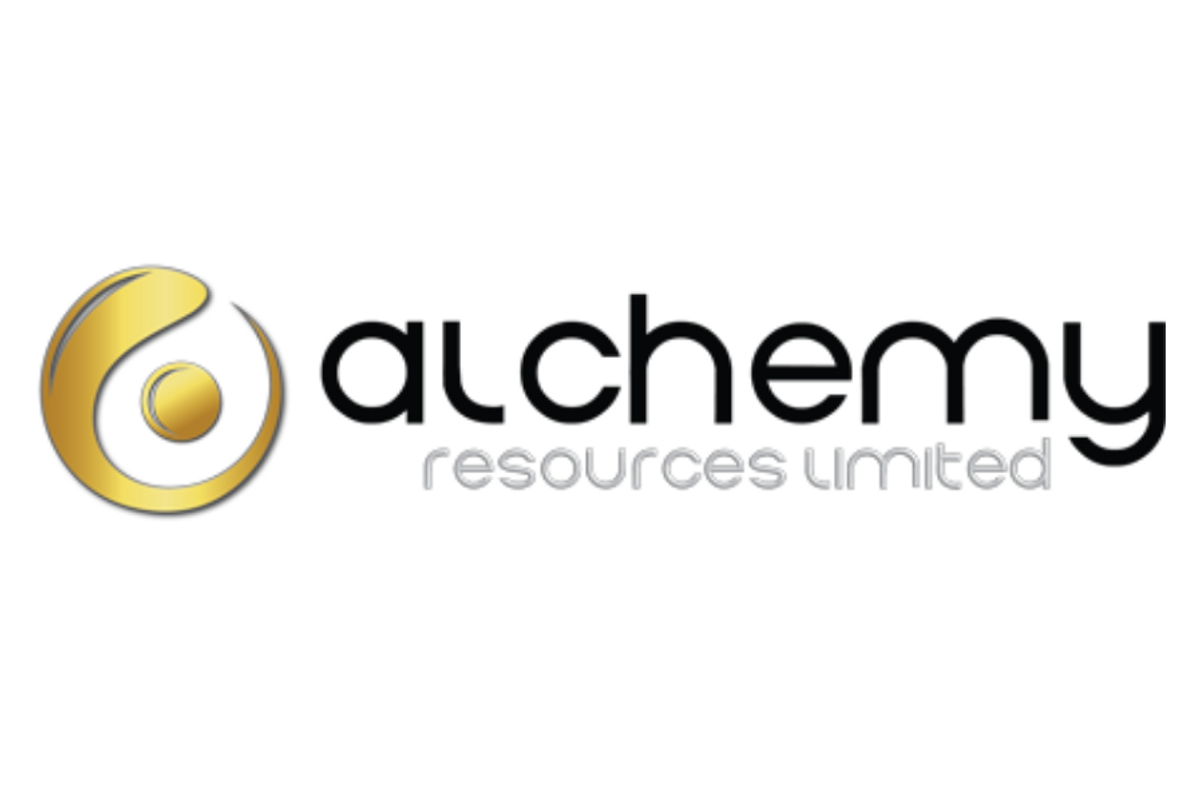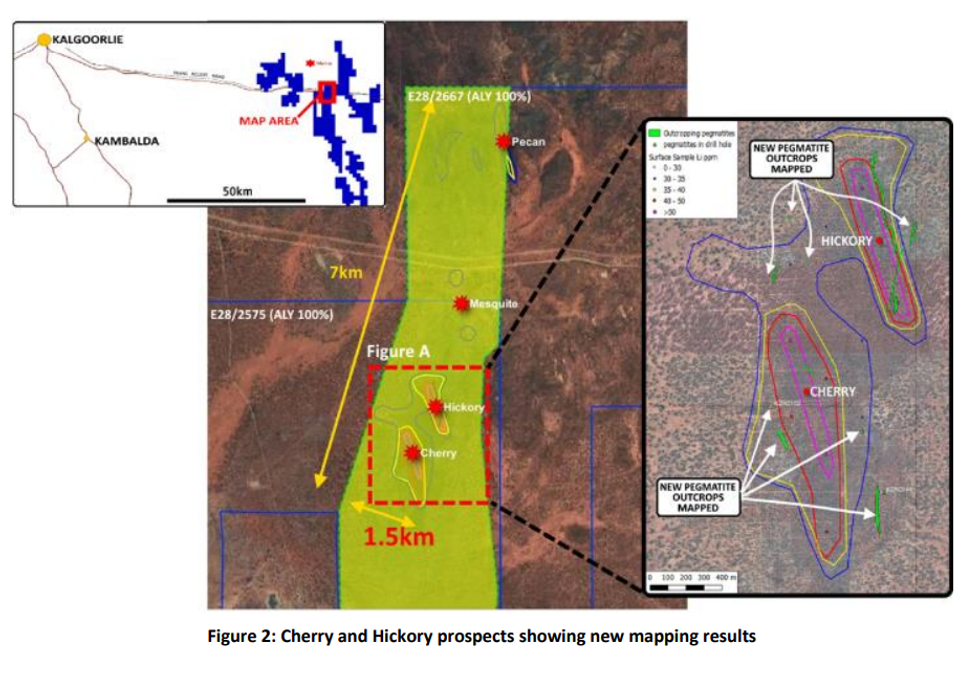
May 26, 2022
Alchemy Resources Limited (ASX: ALY) (“Alchemy” or “the Company”) is pleased to announce it has identified additional outcropping pegmatites at its 100% owned Karonie Gold Project located east of Kalgoorlie in Western Australia. The recent mapping has now identified a pegmatite cluster and has doubled the strike length at the Cherry and Hickory prospects, and has identified multiple outcropping pegmatites at Pecan in the north.
HIGHLIGHTS
- Field work has identified further outcropping pegmatites over the recently discovered lithium in soils anomalies at the 100% owned Karonie Project 110km East of Kalgoorlie.
- Pegmatite cluster mapped over an initial 7km x 1.5km area.
- At Cherry and Hickory Prospects, pegmatites now defined over a 1.5km x 2km area, doubling the previous mapped strike extent.
- At Pecan prospect, outcropping pegmatites have been identified over a strike length of 400m. Outcrops coincide with soil anomalies.
- Rock-chip assays returned significant pathfinder anomalism with Rubidium grades up to 5880ppm, Tantalum up to 122ppm and Caesium up to 221ppm. The ratio analysis of the multi-element data indicates fractionated and highly evolved Lithium-Caesium-Tantalum (LCT) pegmatites over the entire 7km strike.
- Large infill soil geochemistry program planned to commence in late May 2022.
- Regional Soils program commencing concurrently in late May 2022.
Chief Executive Officer Mr James Wilson commented:
“The mapping has now identified a cluster of pegmatites at Karonie. At Hickory and Cherry, we’ve doubled the strike length of mapped pegmatites and at Pecan we’ve discovered multiple pegmatite outcrops across a 1km wide area. We expect the infill soils will zero in on zones which sit under the thin surface cover, and this will help us plan the next steps. The rock-chip assays are all showing very high tenor pathfinder anomalism which plots within the highly evolved and fractionated granite chemistry, telling us that we are exploring in exactly the right spot. Our next steps will be the commencement of infill soils and detailed structural mapping due to start imminently to zero in on target zones for drilling later this year.”
KARONIE PEGMATITE UPDATE
Reconnaissance field mapping at the Cherry-Hickory-Mesquite and Pecan prospects has further extended the known pegmatite occurrences at the Project. Several pegmatite dyke clusters have been identified, indicating the presence of multiple zones which outcrop within the target area. The mineralogy of these bodies appears similar to occurrences identified in earlier zones. Understanding the structural and geochemical controls on these bodies will be a key in defining areas for drill testing. Rock chip results from recent sampling continue to exhibit exceptionally strong pathfinder anomalism with the relevant ratio analysis indicative of evolved and fertile pegmatites with high Tantalum, Rubidium and Caesium results.
Alchemy is preparing field crews to commence infill soil sampling on the priority targets, which is expected to commence in late May 2022.
Cherry and Hickory Mapping: Ground truthing of the lithium anomalies has revealed additional outcropping pegmatites at Cherry and Hickory (Figure 2). In total 6 outcrops were mapped over a combined strike extent of >1.4km (prior ~900m). Individual outcrops have been mapped from 150m to 1,000m in strike extent, with thin cover obscuring other areas. Importantly the mapped pegmatites occur in proximity to the soil anomalies. Pegmatite outcrops have been mapped at the northern and southern extents of the previous soils. Portions of the Cherry and Hickory anomaly are covered by thin soil cover.
Click here for the full ASX Release
This article includes content from Alchemy Resources Limited, licensed for the purpose of publishing on Investing News Australia. This article does not constitute financial product advice. It is your responsibility to perform proper due diligence before acting upon any information provided here. Please refer to our full disclaimer here.
ALY:AU
The Conversation (0)
8h
Long State Funding Update
Atlantic Lithium (A11:AU) has announced Long State Funding UpdateDownload the PDF here. Keep Reading...
24 November
CATL Reportedly Plans to Restart Key Chinese Lithium Mine By December
Contemporary Amperex Technology (SZSE:300750,OTC Pink:CTATF) is preparing to restart its Jianxiawo lithium mine in Jiangxi province as soon as early December, industry sources familiar with the matter told Bloomberg.The sources, who declined to be named, said CATL has asked suppliers and... Keep Reading...
24 November
Liontown Resources’ Spodumene Auction Attracts Nine Countries
Liontown Resources (ASX:LTR,OTC:LINRF) held its first digital spot sales auction for 10,000 wet metric tonnes of spodumene concentrate from its Kathleen Valley lithium operations in Western Australia.The auction, attracting over 50 buyers from nine countries, was conducted on Metalshub, a... Keep Reading...
21 November
Top 5 Canadian Mining Stocks This Week: Sigma Lithium Flips the Switch with 64 Percent Gain
Welcome to the Investing News Network's weekly look at the best-performing Canadian mining stocks on the TSX, TSXV and CSE, starting with a round-up of Canadian and US news impacting the resource sector.Statistics Canada released October’s consumer price index (CPI) data on Monday (November 17).... Keep Reading...
18 November
Ganfeng Chairman’s Forecast Sparks Lithium Price Surge in China
China’s lithium market strengthened sharply on Monday (November 17) after Ganfeng Lithium (OTC Pink:GNENF,HKEX:1772) Chairman Li Liangbin said at a domestic industry conference that demand for the key battery metal could grow by as much as 40 percent in 2026.The most-traded lithium carbonate... Keep Reading...
17 November
Ontario Lithium Project Development Update
Green Technology Metals(GT1:AU) has announced Ontario Lithium Project Development UpdateDownload the PDF here. Keep Reading...
Latest News
Latest Press Releases
Related News
TOP STOCKS
American Battery4.030.24
Aion Therapeutic0.10-0.01
Cybin Corp2.140.00







